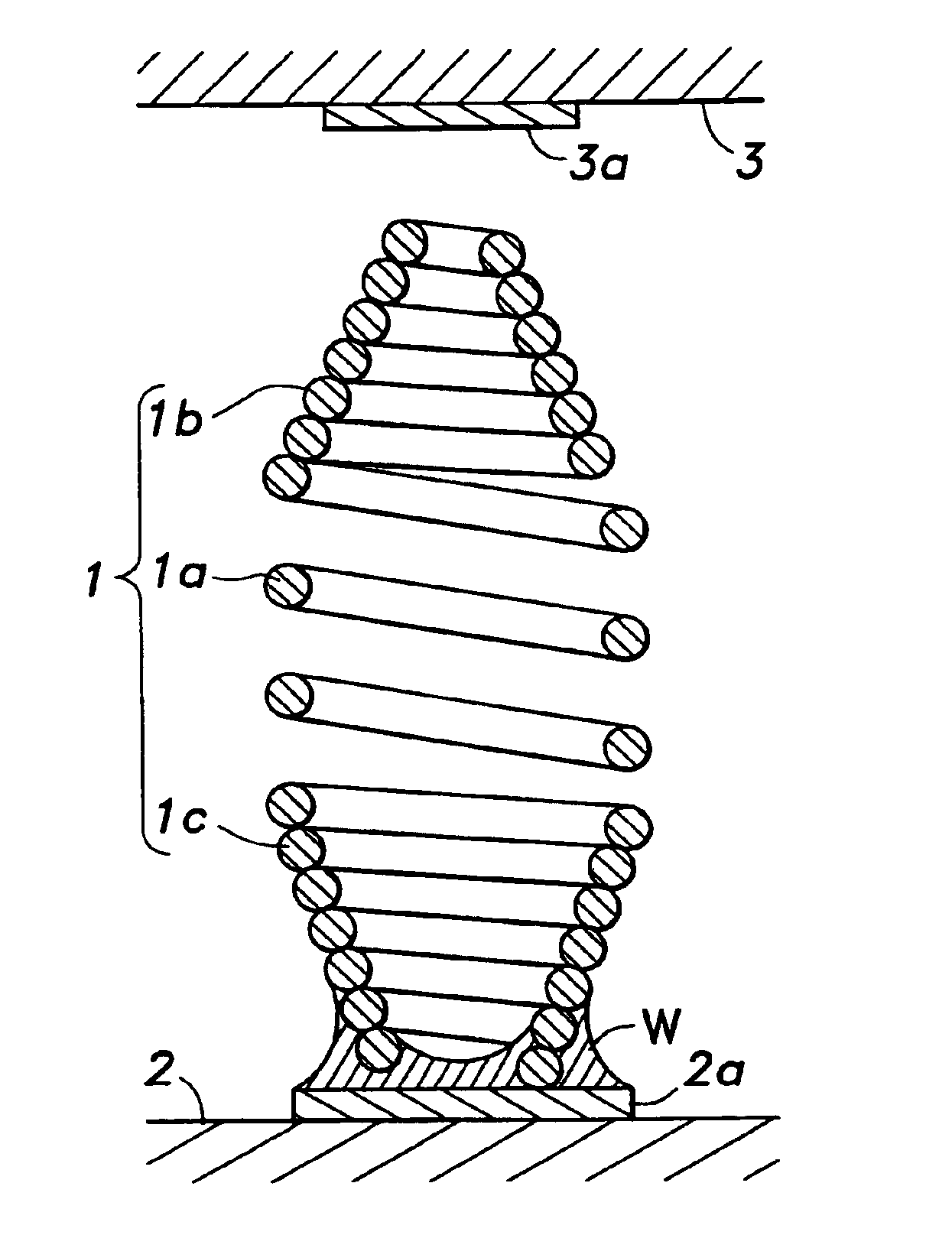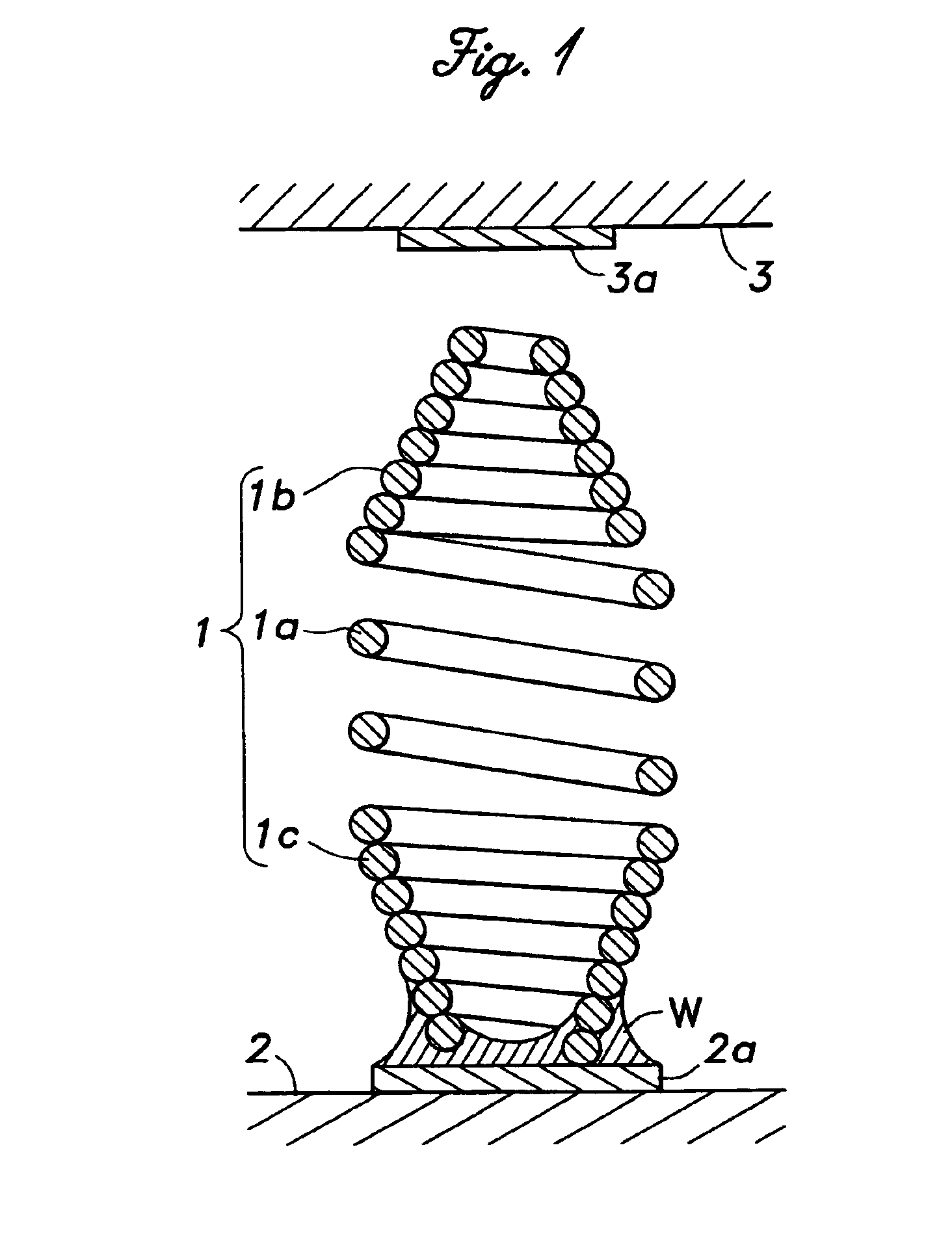Conductive coil contact member
a contact member and conductive coil technology, applied in the direction of electrical testing, measurement devices, instruments, etc., can solve the problems of difficult to reduce the radius of a turn beyond a certain limit for a given diameter of the coil wire, the resiliency or rigidity of the contact member may not be achieved, and the tip of the contact member is difficult to be positioned with respect to the object, etc., to achieve a high level of positional accuracy and low electric inductance and resistance.
- Summary
- Abstract
- Description
- Claims
- Application Information
AI Technical Summary
Benefits of technology
Problems solved by technology
Method used
Image
Examples
second embodiment
FIG. 9 shows the present invention in which the parts corresponding to those of the previous embodiment are denoted with like numerals. In this embodiment, the through hole 9 of the insulating plate member 7 facing away from the circuit board 2 is not different from that of the previous embodiment, but the through hole 11 formed in the lower insulating plate 8 on the side of the circuit board 2 consists of a small diameter portion 11a similar to that shown in FIG. 7 and a large diameter portion 11b provided on the side of the circuit board 2. The large diameter portion 11b is so dimensioned as to expose the circuit terminal 2a even when the lateral relative positioning between the holder and the circuit board 2 is not perfect. The large diameter portion 11a consists of a straight hole, and this simplifies the work of forming the hole.
third embodiment
FIG. 10 shows the present invention in which the parts corresponding to those of the previous embodiments are denoted with like numerals. In this embodiment, the through hole 9 of the insulating plate member 7 facing away from the circuit board 2 is not different from that of the previous embodiment, but the through hole 12 formed in the lower insulating plate 8 on the side of the circuit board 2 consists of a straight small diameter hole extending over the entire thickness of the insulating plate 8. This simplifies the work of forming the hole, and contributes to the reduction of the manufacturing cost.
fourth embodiment
FIG. 11 shows the present invention in which the parts corresponding to those of the previous embodiments are denoted with like numerals. In this embodiment, the holder in this case consists of a single insulating plate member 13 which is connected to the circuit board 2. A through hole 14 passed across the thickness of the insulating plate member 13 comprises a large diameter portion 1c extending from the end adjoining the circuit board 2 over a large part of the thickness of the insulating plate member 13, a small diameter portion 14b extending over a short distance from the end facing away from the circuit board 2, and a tapered portion 14c which smoothly connects the large diameter portion 14a and small diameter portion 14b together.
According to this embodiment, the holder for retaining the conductive coil contact member 1 can be simplified. Similarly as the embodiment illustrated in FIG. 7, the conical electrode portion 1b resiliently abuts the tapered portion 14c of the throug...
PUM
 Login to View More
Login to View More Abstract
Description
Claims
Application Information
 Login to View More
Login to View More - R&D
- Intellectual Property
- Life Sciences
- Materials
- Tech Scout
- Unparalleled Data Quality
- Higher Quality Content
- 60% Fewer Hallucinations
Browse by: Latest US Patents, China's latest patents, Technical Efficacy Thesaurus, Application Domain, Technology Topic, Popular Technical Reports.
© 2025 PatSnap. All rights reserved.Legal|Privacy policy|Modern Slavery Act Transparency Statement|Sitemap|About US| Contact US: help@patsnap.com



